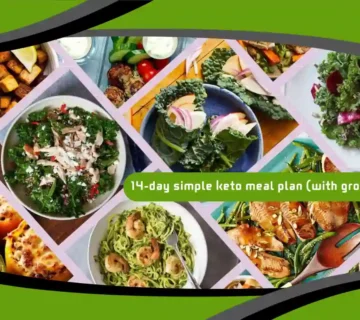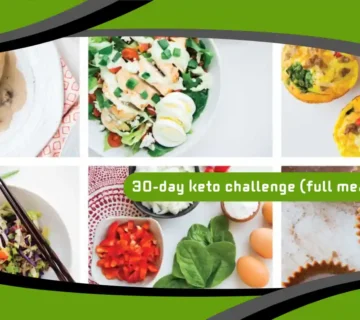A ketogenic lifestyle revolves around a high-fat, moderate-protein, and low-carbohydrate eating approach. It requires consistency in food choices to maintain a metabolic state known as ketosis. In this state, the body efficiently burns fat for fuel instead of glucose. A typical keto day is less about deprivation and more about strategic eating, satiety, and fueling your body with nutrient-dense foods. To truly succeed on keto, planning your meals and understanding the macros involved are critical to staying within your limits and optimizing your results.

Starting Your Day with Hydration
Before diving into breakfast, many keto followers start their morning with hydration. Since keto has a natural diuretic effect, staying hydrated is key. A glass of water with a pinch of sea salt, lemon, or even apple cider vinegar is a common choice. Some prefer to begin the day with warm water and electrolytes to replenish sodium and minerals. Maintaining electrolyte balance prevents fatigue, headaches, and other common keto flu symptoms. This simple morning routine sets the stage for energy and focus throughout the day.
Morning Energy with Bulletproof Coffee
One of the most iconic keto rituals is bulletproof coffee. This high-fat coffee typically blends brewed coffee with MCT oil, grass-fed butter, or ghee. It provides a quick energy source and supports mental clarity without raising blood sugar levels. This coffee can replace a full breakfast for those practicing intermittent fasting or be part of a larger meal if additional nutrients are needed. It’s a staple in many keto mornings because it’s fast, satisfying, and fuels the brain with clean-burning fats.
A Typical Keto Breakfast Plate
For those who prefer a solid breakfast, a typical keto morning meal might include scrambled eggs with spinach and cheese, avocado slices, and a few turkey or beef sausage links. These ingredients provide protein, healthy fats, and essential vitamins like B12 and choline. The inclusion of leafy greens ensures fiber intake, which can sometimes be a challenge on keto. This kind of breakfast is not only filling but also supports steady energy levels and keeps you satisfied until your next meal.
Managing Mid-Morning Hunger
Depending on activity levels and metabolism, some people might feel hungry mid-morning. Instead of turning to carb-heavy snacks, keto-friendly options include boiled eggs, a handful of almonds, or cheese sticks. These snacks are high in fat and protein, helping maintain satiety. Choosing whole food snacks over processed bars also ensures you’re avoiding hidden carbs and preservatives. Planning ahead by keeping small portions of keto snacks on hand prevents impulsive eating and keeps your macros on track.
Low-Carb Lunch Ideas for Sustained Energy
Lunch on a keto day is typically centered around a quality protein source and low-carb vegetables. Grilled chicken thighs with roasted cauliflower and a generous drizzle of olive oil is a classic combo. Another popular option is a large salad with mixed greens, feta cheese, olives, avocado, and tuna, dressed with olive oil and lemon juice. These meals are nutrient-rich and keep energy stable without the post-lunch crash that often follows high-carb meals.
Importance of Healthy Fats During Lunch
Incorporating enough fat into your lunch is essential for staying in ketosis. This can be achieved through salad dressings made with avocado or olive oil, fatty fish like salmon, or toppings like seeds and cheese. These additions not only enhance flavor and texture but also support hormonal function and satiety. Without sufficient fat, you may feel unsatisfied, increasing the temptation to snack unnecessarily. Balancing fat with fiber and protein is key to feeling full and energized.
Keto-Friendly Beverages Throughout the Day
Staying hydrated on keto is crucial, and it goes beyond just water. Herbal teas, bone broth, and electrolyte drinks are excellent additions throughout the day. Sparkling water with lime or a splash of apple cider vinegar can also be refreshing and supportive of digestion. Avoiding sugary drinks, even diet sodas, is recommended to maintain insulin sensitivity and avoid artificial sweeteners that may trigger cravings or disrupt gut health in sensitive individuals.
Navigating Afternoon Slumps with Smart Choices
Many people experience energy dips in the late afternoon. On keto, this can usually be avoided with proper nutrition earlier in the day. However, if hunger strikes, a small fat-based snack like macadamia nuts or a keto smoothie with almond milk, avocado, and cocoa powder can help. Such snacks offer mental clarity and a gentle energy boost without raising blood sugar or insulin levels, making them perfect for powering through the rest of the day.
A Look at a Satisfying Keto Dinner
Dinner is often the most enjoyable meal of a keto day. Popular options include grilled salmon with asparagus sautéed in butter, or a bunless burger with bacon, lettuce, tomato, and homemade aioli. Zucchini noodles with a creamy Alfredo sauce made from heavy cream and parmesan can replace pasta cravings without the carb load. These meals are hearty, comforting, and ideal for replenishing nutrients after a long day while keeping you in ketosis.
Using Herbs and Spices to Elevate Flavor
One way to avoid meal boredom is by using a wide range of herbs and spices. Garlic, turmeric, cumin, oregano, rosemary, and paprika add depth to keto meals and come with added health benefits such as anti-inflammatory and digestive properties. These seasonings transform simple ingredients into delicious, crave-worthy dishes without the need for sugar or starch-based sauces.
Post-Dinner and Late-Night Keto Snacks
If you find yourself needing something after dinner, choose a small keto-friendly option like a few olives, dark chocolate (above 85%), or coconut milk chia pudding. These treats are satisfying and can prevent late-night carb cravings. It’s important to listen to your hunger cues and avoid snacking out of habit. If you’re not truly hungry, a hot herbal tea might do the trick and support digestion and relaxation.
Sleep and the Keto Diet
Getting quality sleep is vital on any diet, but especially on keto. A well-formulated keto plan helps stabilize blood sugar and hormones like cortisol and insulin, which can improve sleep patterns. Avoiding heavy meals or caffeine late in the day supports restful sleep. Magnesium-rich foods like spinach or a light supplement can also ease you into deep sleep, helping your body repair and recharge overnight.
Meal Prep as a Daily Habit
Preparing meals in advance helps avoid temptation and ensures macro consistency. Having cooked meats, chopped vegetables, and sauces ready to go reduces decision fatigue and makes it easier to stay compliant. Many keto eaters batch-cook on weekends and store meals in portioned containers. This habit is especially helpful for those with busy schedules or anyone new to the keto lifestyle.
Understanding Macros and Portion Control
A typical day on keto isn’t just about what you eat, but how much. Tracking macros helps ensure you’re staying within your carb limits while eating enough fat and protein. Apps like MyFitnessPal or Cronometer can simplify this process. While keto allows generous portions of fat, it’s still essential to be mindful of overall intake, especially for those with weight loss goals.
Social Eating on Keto
Dining out or attending events can be tricky, but with the right approach, it’s manageable. Look for grilled meats, steamed vegetables, and ask for dressings or sauces on the side. Avoid bread, pasta, and starchy sides, and don’t hesitate to request substitutions. Many restaurants are keto-friendly without even realizing it — it just takes a bit of awareness and assertiveness.
How Exercise Fits Into a Keto Day
Exercise complements a ketogenic lifestyle by improving insulin sensitivity and supporting fat metabolism. Whether it’s a walk, a strength training session, or a yoga class, being active enhances energy and mood. Some people on keto adjust their fat and protein intake slightly around workouts, especially if performance is a priority.
Supplements to Support a Keto Lifestyle
While a well-balanced keto diet can meet most nutritional needs, certain supplements may support optimal health. Magnesium, potassium, sodium, omega-3 fatty acids, and vitamin D are commonly used. Electrolyte powders and collagen peptides are also popular for maintaining hydration and joint health, especially during the early adaptation phase.
Avoiding Common Mistakes
A typical keto day can be disrupted by sneaky carbs in sauces, processed snacks, or too many nuts. Staying aware of portion sizes, reading labels, and avoiding “lazy keto” habits ensures lasting results. Regular check-ins with your goals and how you feel physically can help identify and correct patterns before they become problems.
Wrapping Up Your Day with Intention
Ending the day with a moment of reflection, gratitude, or goal-setting helps reinforce discipline and mindfulness. Whether it’s reviewing your food log, prepping for tomorrow’s meals, or enjoying a calming tea, these rituals create a sense of control and success. A typical day on keto isn’t about perfection — it’s about consistency, smart choices, and honoring your body with every meal.
Watch also: Winter Keto Comfort Foods: The Perfect Low-Carb Meal Plan to Beat the Cold



No comment